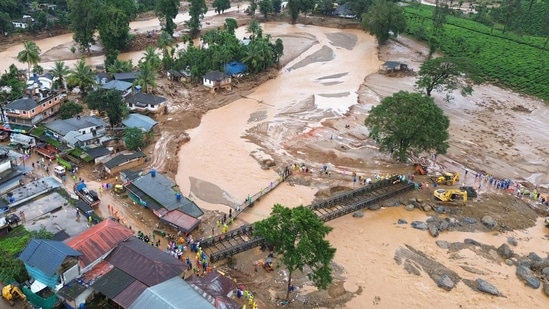New landslide hotspots found in Himalayas, Western Ghats, warns survey
Infrastructural development and deforestation apart from climate change are critical reasons why the frequency of landslides is going up in vulnerable areas.
Vulnerable slopes in landslide-prone areas should be stabilised urgently using bio-engineering and structural geotechnical solutions, RMSI, a global disaster risk management firm, has said.

RMSI has flagged that infrastructural development, deforestation, and vegetation removal apart from climate change, are critical reasons why the frequency of landslides is going up in vulnerable areas. Its analysis indicates that Himachal Pradesh and Uttarakhand have reported a higher number of landslide-related deaths in recent years and that certain Himalayan districts and the Western Ghats have reported a steep increase in landslides, more so since 2006.
RMSI is a private consultancy that provides mainly geospatial and engineering solutions. It recently conducted a country-wide analysis of areas vulnerable to landslides. It found that the most landslide-prone states in India are Arunachal Pradesh, Sikkim, Kerala, Meghalaya, Maharashtra, Manipur, Uttarakhand, and Himachal Pradesh, with the last two facing a relatively higher risk and impact.
Landslides caused over 150 deaths in Himachal Pradesh and around 70 in Uttarakhand between 2022 and September 2023, data from the disaster management division of the home ministry show.
Analysis revealed that Himachal Pradesh and Uttarakhand recorded 22% and 32% increase in population density between 2001 and 2019.
"The increase in tourism due to easy access from nearby cities like Delhi, Chandigarh, etc, and the holy significance of several sites in these states have contributed to this growth in tourism. The development of a large number of hydroelectric projects has also opened up greater avenues for settlement and tourism," RMSI said in the report.
Although Himalayan states and the Western Ghats have always been landslide-prone, there are new hotspot areas where landslides are now a significant concern, RMSI said.
Four areas in northern Himalaya (Ramban, J&K), central Himalaya (Chamoli and Pithoragarh stretch in Uttarakhand), eastern Himalayan (Darjeeling) and one from Western Ghat (Idukki, Kerala) were studied in the context of increasing frequency of fatal landslides over the last few decades. The same areas have gone through rapid changes in land use including the expansion of built-up areas and road infrastructure.
"One typical pattern in all of these areas indicates that they have undergone tremendous change in terms of land use. Roughly 30-40 % of these towns/cities have consistently increased total built-up areas. These areas have also registered significant growth in road infrastructure and major engineering projects like hydroelectric projects," RMSI said, adding that data indicates a steep increase in landslides in these districts.
RMSI concluded that “in addition to climate change, the profound impact of human activities like infrastructural development, deforestation, and vegetation removal are critical reasons for further enhancing the frequency of landslides in the country. Preserving natural landscapes is critical for ensuring their stability, as development in these regions can make once-stable slopes more susceptible to catastrophic landslides.”
An increase in road network may be contributing to landslide occurrence in hilly states, the report said. As per the road, transport and highways ministry, the road length of the country has increased from 399,942 sq. km in 1950 to 6,295,717 sq. km in 2021.
RMSI has found that a lot of areas in the country, which are under a 25–45-degree slope are vulnerable to landslides. Landslide protection measures may include retaining walls, soil nailing, ground anchors, slope grouting, geosynthetic mats, geogrids, jute geotextiles, and other interventions. These landslide mitigation activities are resource-intensive and they may add to the cost of the project to be executed but proper application of the procedures has long-term economic and social benefits, RMSI said.
Further, when construction projects are taken up in hill states, a thorough geological investigation of the project region should be carried out. An important way to prevent landslides in hilly regions is to have region-specific building laws that take note of existing ecological constraints in the area, RMSI recommended.
It added that unplanned construction, illegal mining, quarrying, and large hydropower projects loosen and remove soil, gravel, and vegetation, leading to lower groundwater retention capabilities, which then increases the risk of flooding.
"A recent example of human-induced damage creating a higher risk of landslides is the Char Dam Road construction process, which activated new potential landslide zones in Uttarakhand due to the damage the construction caused to the fragile Himalayan ecosystem. According to the National Crime Records Bureau data, 65% of 2019's landslide fatalities happened in the Himalayas or the Western Ghats," the report said.
On Kerala landslides, RMSI said that over the past five years, Mundakkai has experienced a significant increase in tourism and developed into a popular destination with numerous resorts and homestays. However, this rapid and unplanned development on a hilly terrain, characterised by the construction of roads, buildings, highways, and forest destruction, has dramatically altered the town's landscape and land use.
HT reported on Wednesday that bursts of rain, 10% heavier due to the climate crisis, and a 62% reduction in forest cover that has increased the susceptibility of slopes are likely to have triggered landslides in Wayanad.
While scientists have highlighted the limited nature of studies in the region, the analysis found the role of the climate crisis and change in land-use patterns was undeniable.
“The landslides that killed hundreds of people in Wayanad, northern Kerala, were triggered by a burst of rainfall that was made about 10% heavier by human-caused climate change,” the analysis by World Weather Attribution, an international collaboration of scientists who analyse the influence of climate change on extreme weather events, said.
Continue reading with HT Premium Subscription






